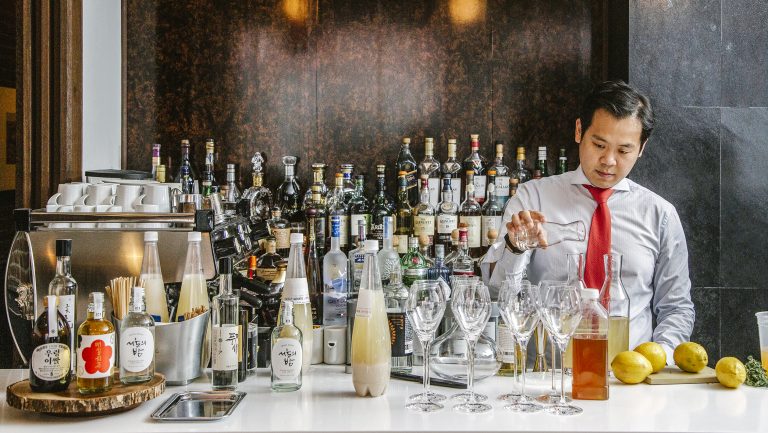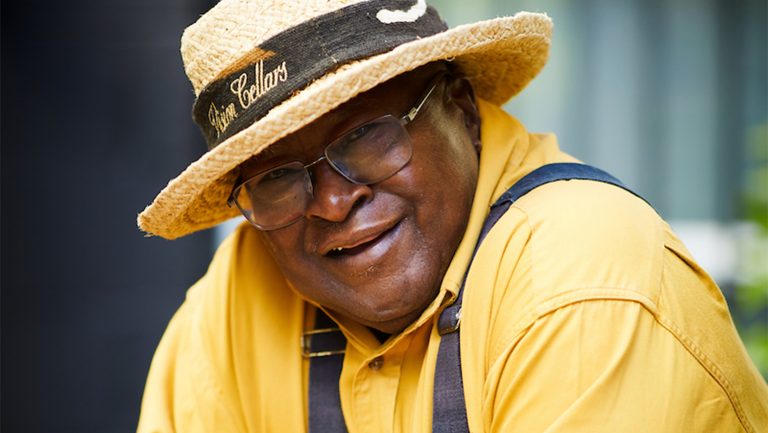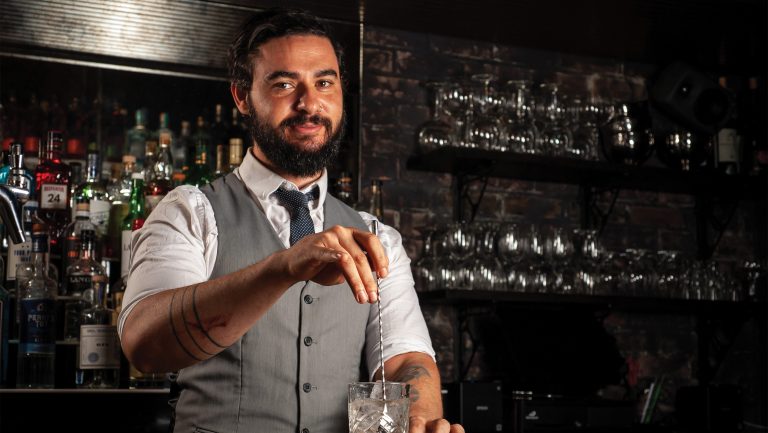When sommelier Kyungmoon Kim helped open Jungsik in New York City in 2011, he built an enviable wine cellar to complement chef Jungsik Yim’s high-concept Korean tasting menus. Kim stocked everything from older vintages of Premier Cru Burgundy to Gaia Assyrtiko and Malbec from France’s Cahors region.
But Kim, a Korean native who came to the U.S. in 1999, was disappointed to find so little premium Korean sool (the country’s term for all alcoholic beverages) available in America. “There was just a lot of inexpensive soju that wouldn’t work with the food we were serving,” recalls Kim, who joined the ranks of Master Sommeliers in 2016. “Guests would always ask for Korean beverages, so I knew the demand was there.”
Kim became determined to fill this niche. In January 2020, he launched KMS Imports, a first-of-its-kind portfolio of Korean sool, which features a small selection from nine producers. Kim wants to teach Americans about Korea’s brewing and distilling traditions and establish premium soju as a major spirits category.

Don’t miss the latest drinks industry news and insights. Sign up for our award-winning newsletters and get insider intel, resources, and trends delivered to your inbox every week.
“I just decided to take on this mission, to import premium products and break the paradigm of soju being watered-down vodka,” Kim says.
Reclaiming an Ancient Tradition
Koreans have been brewing rice-based alcohol for close to 2,000 years and distilling soju since the 13th century. But Japanese colonialism and the Korean War nearly wiped out the craft. In 1965, with famine looming, the Korean government banned the use of rice in alcohol production, a move that led to industry consolidation and the rise of industrial soju made from wheat, tapioca, sweet potatoes, and other commodity starches. That low-quality soju, pumped up with flavorings and additives, has dominated the market and Korean drinking customs ever since.

In the past few years, a handful of high-end sojus have emerged on the U.S. market, notably Hwayo from Korea; Tokki, a Brooklyn brand that moved its operations to Seoul this year; and Yobo, a grape-based soju distilled in upstate New York. However, in comparing Korean alcoholic beverages to other categories, Kim says there were too few options to proudly serve with fine cuisine, not to mention a lack of understanding about what makes Korean sool unique.
Ellia Park, founder and manager of Korean restaurants Atoboy and Atomix in New York City, believes there’s a fair amount of confusion about the differences between Korean sool and such Japanese beverages as sake. “From the ingredients used to the techniques applied to make the beverage, sool is a distinct category for beverage professionals to study and learn,” says Park.
Kim wants to supply the growing number of new-school Korean restaurants, including Atoboy and Atomix, whose chef-owner, Junghyun Park, is a Jungsik alumni. “My vision is to distribute to more refined Korean restaurants that don’t just target Koreans, but also people who have a much broader experience with beverages like fine wine and single malt whiskey,” says Kim, who began to formalize plans for KMS Imports in early 2019.
From Fine Wine to Soju
Kim, who was born in Seoul in 1983, attended high school in the United States to learn English and then studied cooking at the Culinary Institute of America, where he befriended fellow student and future collaborator Jungsik Yim. After returning to Korea for compulsory military duty, Kim continued to pursue his wine education through the Court of Master Sommeliers. He reunited with Yim in 2009 to open Jungsik in Seoul. It was a groundbreaking restaurant that helped introduce Western-style tasting menus to Korea. Next, the duo opened Jungsik in New York, which earned two Michelin stars in 2014.
In 2015, Kim landed a wine-focused role at The Modern with Master Sommelier Michael Engelmann. After passing his Master Sommelier exam just five months later, Kim set his sights on his next goal: introducing the U.S. to premium sool.
“I believe soju can follow in the footsteps of mezcal: Fifteen years ago, you could only find the cheapest grade bottles with worms inside. Now you can find mezcal behind every bar, and people appreciate nuances in flavor profiles and regional production.”
The Hunt for Producers
Kim went searching throughout Korea for artisan distillers who were crafting sool in the pre-war brewing tradition with a focus on terroir. Korea’s traditional beverages are made with only rice, water, and nuruk, a grain cake that contains different strains of yeast, bacteria, and koji. (In contrast, Japanese brewing uses a single strain of koji for fermentation.) As is the case with natural yeast in natural winemaking, the microbial composition of nuruk varies with geography and climate and “really, truly reflects terroir,” Kim explains.
In Seoul, he reached out to Kim Taek-sang, who runs Samhae Soju Ga distillery, and has been designated an intangible cultural heritage asset. Samhae translates to “three pigs,” and it’s a reference to a traditional three-step rice-brewing process that begins on the day of the pig, according to the Chinese zodiac calendar.
“It’s sort of mystical, almost like following the biodynamic calendar,” Kim says. “They believe pig’s blood is the purest and cleanest of the animals. So in order to brew clean alcohol, they brew on the day of pig.”
Samhae’s base sool next ferments for 108 days, which allows it to develop incredible complexity, according to Kim, and because “traditional soju is distilled just once, it really retains all the essence of the base sool.”
Kim’s portfolio includes five other sojus, ranging from Sulseam’s classic rice-based Mir soju to Solsongju Damsoul pine soju. The latter is made by co-fermenting rice with spruce and pine needles. After distillation, the spirit is proofed by adding spruce-pine tea. There’s also Won Mae plum liqueur from The Han; Yangchon’s chungju, a clear, golden-hued, and savory rice wine often compared to sake; and makgeolli, a cloudy rice wine. Kim’s Red Monkey makgeolli from Sulseam is an unusual bright pink, the result of inoculating its nuruk with a red yeast strain.

Coming to America
KMS Imports debuted during the beginning of the pandemic, and many placements—including Le Bernardin and The Modern—have been put on hold, But Kim’s encouraged by early interest, particularly from high-end Korean chefs. Pastry chef Jiho Kim, who worked with Kim at The Modern, recently launched Joomak, a pop-up in New York’s Koreatown. “We wanted drinks to match the quality of our food, and Kyungmoon’s sojus work so well with our dishes,” says Jiho Kim. “I usually pour a little taste, and the feedback we get is that the flavor and texture are totally different than what guests are used to.”
The Parks highlighted KMS’s Damsoul pine soju in a collaboration between Atoboy and cocktail bar Dante, and they’re now incorporating Kim’s sool into dishes and pairings at Atomix. “When a diner enjoys a sake that complements Japanese dishes, it multiplies the sensation. In the same way, we are overjoyed to be offering that kind of experience to our guests, where the expression of our Korean cuisine can be amplified through sool,” Park says.
Next, Kim plans to expand KMS Imports to California, followed by Washington, D.C., and Georgia. He’s also pushing to have sool included in sommelier coursework.
“Soju has its own unique story, and once people understand it, they will want to learn more.”
“I believe soju can follow in the footsteps of mezcal: Fifteen years ago, nobody knew mezcal,” Kim says. “You could only find the cheapest grade bottles with worms inside. Now, regardless of cuisine, you can find mezcal behind the bar, and people appreciate nuances in flavor profiles and regional production. Soju has its own unique story, and once people understand it, they will want to learn more.”

Dispatch
Sign up for our award-winning newsletter
Don’t miss the latest drinks industry news and insights—delivered to your inbox every week.
Caroline Hatchett writes about food, wine, and cocktails for Wine Enthusiast, CNN Travel, Eater, Heated, Robb Report, Liquor.com, and The Counter.







